

Modal realism. The term possible world[edit] The term goes back to Leibniz's theory of possible worlds, used to analyse necessity, possibility, and similar modal notions.
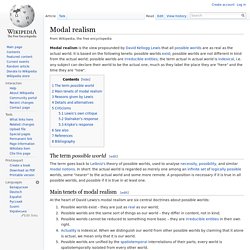
In short: the actual world is regarded as merely one among an infinite set of logically possible worlds, some "nearer" to the actual world and some more remote. A proposition is necessary if it is true in all possible worlds, and possible if it is true in at least one. Main tenets of modal realism[edit] At the heart of David Lewis's modal realism are six central doctrines about possible worlds: Reasons given by Lewis[edit] Lewis believes that the concept of alethic modality can be reduced to talk of real possible worlds. Taking this latter point one step further, Lewis argues that modality cannot be made sense of without such a reduction. Parallel universe (fiction) A parallel universe is a hypothetical self-contained separate reality co-existing with one's own.

A specific group of parallel universes is called a "multiverse", although this term can also be used to describe the possible parallel universes that constitute reality. While the terms "parallel universe" and "alternative reality" are generally synonymous and can be used interchangeably in most cases, there is sometimes an additional connotation implied with the term "alternative reality" that implies that the reality is a variant of our own. The term "parallel universe" is more general, without any connotations implying a relationship, or lack of relationship, with our own universe. A universe where the very laws of nature are different – for example, one in which there are no Laws of Motion – would in general count as a parallel universe but not an alternative reality and a concept between both fantasy world and earth. In 1884, Edwin A. List of paradoxes. This is a list of paradoxes, grouped thematically.
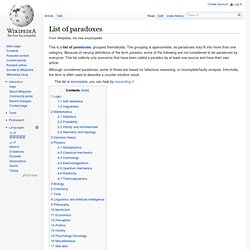
The grouping is approximate, as paradoxes may fit into more than one category. Because of varying definitions of the term paradox, some of the following are not considered to be paradoxes by everyone. This list collects only scenarios that have been called a paradox by at least one source and have their own article. Although considered paradoxes, some of these are based on fallacious reasoning, or incomplete/faulty analysis. Informally, the term is often used to describe a counter-intuitive result. Logic[edit] Self-reference[edit] These paradoxes have in common a contradiction arising from self-reference. Barber paradox: A barber (who is a man) shaves all and only those men who do not shave themselves. Vagueness[edit] Ship of Theseus (a.k.a. List of fiction employing parallel universes. Infinity.
The ∞ symbol in several typefaces History[edit] Ancient cultures had various ideas about the nature of infinity.
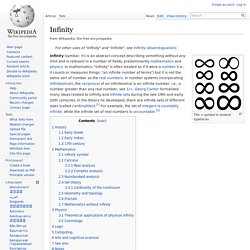
The ancient Indians and Greeks did not define infinity in precise formalism as does modern mathematics, and instead approached infinity as a philosophical concept. Early Greek[edit] Infinity (philosophy) The Isha Upanishad of the Yajurveda (c. 4th to 3rd century BC) states that "if you remove a part from infinity or add a part to infinity, still what remains is infinity".

The Jain mathematical text Surya Prajnapti (c. 400 BC) classifies all numbers into three sets: enumerable, innumerable, and infinite. Each of these was further subdivided into three orders: Enumerable: lowest, intermediate and highestInnumerable: nearly innumerable, truly innumerable and innumerably innumerableInfinite: nearly infinite, truly infinite, infinitely infinite.
Ultrafinitism. In the philosophy of mathematics, ultrafinitism, also known as ultraintuitionism, strict-finitism, actualism, and strong-finitism is a form of finitism.
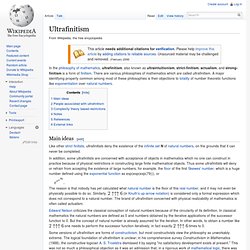
There are various philosophies of mathematics which are called ultrafinitism. A major identifying property common among most of these philosophies is their objections to totality of number theoretic functions like exponentiation over natural numbers. Main ideas[edit] Multiverse. Omniverse. Metaverse. The Metaverse is a collective virtual shared space, created by the convergence of virtually enhanced physical reality and physically persistent virtual space,[1] including the sum of all virtual worlds, augmented reality, and the internet.

The word metaverse is a portmanteau of the prefix "meta" (meaning "beyond") and "universe" and is typically used to describe the concept of a future iteration of the internet, made up of persistent, shared, 3D virtual spaces linked into a perceived virtual universe.[2] Developing technical standards for the Metaverse[edit] Conceptually, the Metaverse describes a future internet of persistent, shared, 3D virtual spaces linked into a perceived virtual universe,[2] but common standards, interfaces, and communication protocols between and among virtual environment systems are still in development. Membrane (M-theory) In string theory and related theories, D-branes are an important class of branes that arise when one considers open strings.
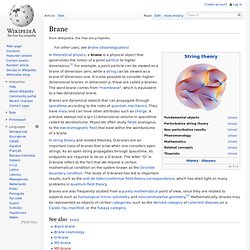
As an open string propagates through spacetime, its endpoints are required to lie on a D-brane. The letter "D" in D-brane refers to the fact that we impose a certain mathematical condition on the system known as the Dirichlet boundary condition. The study of D-branes has led to important results, such as the anti-de Sitter/conformal field theory correspondence, which has shed light on many problems in quantum field theory. See also[edit] References[edit] Jump up ^ Moore, Gregory (2005). Philosophy of space and time. Philosophy of space and time is the branch of philosophy concerned with the issues surrounding the ontology, epistemology, and character of space and time.
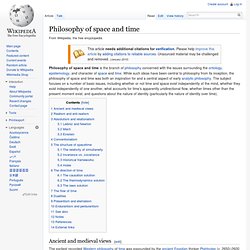
While such ideas have been central to philosophy from its inception, the philosophy of space and time was both an inspiration for and a central aspect of early analytic philosophy. The subject focuses on a number of basic issues, including whether or not time and space exist independently of the mind, whether they exist independently of one another, what accounts for time's apparently unidirectional flow, whether times other than the present moment exist, and questions about the nature of identity (particularly the nature of identity over time). Ergodic hypothesis. The ergodic hypothesis is often assumed in the statistical analysis of computational physics.

The analyst would assume that the average of a process parameter over time and the average over the statistical ensemble are the same. This assumption that it is as good to simulate a system over a long time as it is to make many independent realizations of the same system is not always correct. (See, for example, the Fermi–Pasta–Ulam experiment of 1953.) Phenomenology[edit] In macroscopic systems, the timescales over which a system can truly explore the entirety of its own phase space can be sufficiently large that the thermodynamic equilibrium state exhibits some form of ergodicity breaking. However, complex disordered systems such as a spin glass show an even more complicated form of ergodicity breaking where the properties of the thermodynamic equilibrium state seen in practice are much more difficult to predict purely by symmetry arguments.
Eternal inflation. Eternal inflation is predicted by many different models of cosmic inflation. MIT professor Alan H. Guth proposed an inflation model involving a "false vacuum" phase with positive vacuum energy. Parts of the Universe in that phase inflate, and only occasionally decay to lower-energy, non-inflating phases or the ground state. Multiverse (religion) In religion a multiverse is the concept of a plurality of universes.
Some religious cosmologies propose that the cosmos is not the only one that exists. The concept of infinite worlds is mentioned in the Apannaka Jataka: "Disciples," the Buddha said "nowhere between the lowest of hells below and the highest heaven above, nowhere in all the infinite worlds that stretch right and left, is there the equal, much less the superior, of a Buddha. Incalculable is the excellence which springs from obeying the Precepts and from other virtuous conduct. " - Apannaka Jataka. Eternal return. Eternal return (also known as "eternal recurrence") is a concept that the universe has been recurring, and will continue to recur, in a self-similar form an infinite number of times across infinite time or space.
The concept is found in Indian philosophy and in ancient Egypt and was subsequently taken up by the Pythagoreans and Stoics. Dyson's eternal intelligence. The intelligent beings would begin by storing a finite amount of energy. They then use half (or any fraction) of this energy to power their thought. When the energy gradient created by unleashing this fraction of the stored fuel was exhausted, the beings would enter a state of zero-energy-consumption until the universe cooled. Once the universe had cooled sufficiently, half of the remaining half (one quarter of the original energy) of the intelligent beings' fuel reserves would once again be released, powering a brief period of thought once more. This would continue, with smaller and smaller amounts of energy being released. Cyclic model. A cyclic model (or oscillating model) is any of several cosmological models in which the universe follows infinite, or indefinite, self-sustaining cycles.
Buddhist cosmology. Hindu cosmology. In Hindu cosmology the universe is cyclically created and destroyed. Hindu cycle of the universe. See also Hindu units of measurement. This is similar to the Cyclical Universe Theory in physical cosmology. The All. Shape of the Universe. Cosmological principle. Astronomer William Keel explains: Ultimate fate of the universe. Ekpyrotic universe. Fine-tuned Universe.